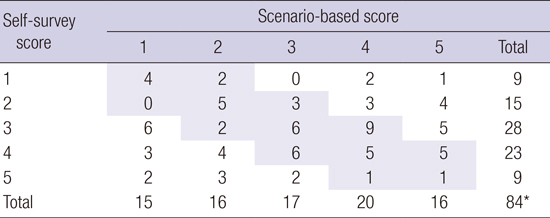1. Alagappan K, Holliman CJ. History of the development of international emergency medicine. Emerg Med Clin North Am. 2005; 23:1–10.
2. Ro YS, Shin SD, Jeong J, Kim MJ, Jung YH, Kamgno J, Alain EM, Hollong B. Evaluation of demands, usage and unmet needs for emergency care in Yaoundé, Cameroon: a cross-sectional study. BMJ Open. 2017; 7:e014573.
3. Terry B, Bisanzo M, McNamara M, Dreifuss B, Chamberlain S, Nelson SW, Tiemeier K, Waters T, Hammerstedt H. Task shifting: meeting the human resources needs for acute and emergency care in Africa. Afr J Emerg Med. 2012; 2:182–187.
4. Aufderheide TP, Nolan JP, Jacobs IG, van Belle G, Bobrow BJ, Marshall J, Finn J, Becker LB, Bottiger B, Cameron P, et al. Global health and emergency care: a resuscitation research agenda--part 1. Acad Emerg Med. 2013; 20:1289–1296.
5. Busse H, Azazh A, Teklu S, Tupesis JP, Woldetsadik A, Wubben RJ, Tefera G. Creating change through collaboration: a twinning partnership to strengthen emergency medicine at Addis Ababa University/Tikur Anbessa Specialized Hospital--a model for international medical education partnerships. Acad Emerg Med. 2013; 20:1310–1318.
6. Osei-Ampofo M, Oduro G, Oteng R, Zakariah A, Jacquet G, Donkor P. The evolution and current state of emergency care in Ghana. Afr J Emerg Med. 2013; 3:52–58.
7. Reynolds TA, Mfinanga JA, Sawe HR, Runyon MS, Mwafongo V. Emergency care capacity in Africa: a clinical and educational initiative in Tanzania. J Public Health Policy. 2012; 33:Suppl 1. S126–S137.
9. Kingue S, Rosskam E, Bela AC, Adjidja A, Codjia L. Strengthening human resources for health through multisectoral approaches and leadership: the case of Cameroon. Bull World Health Organ. 2013; 91:864–867.
10. Kane MT. The assessment of professional competence. Eval Health Prof. 1992; 15:163–182.
11. Epstein RM, Hundert EM. Defining and assessing professional competence. JAMA. 2002; 287:226–235.
12. Jung HY, Kim JW, Lee S, Yoo SH, Jeon JH, Kim TW, Park JS, Jeong SY, Oh SJ, Kim EJ, et al. A study of core humanistic competency for developing humanism education for medical students. J Korean Med Sci. 2016; 31:829–835.
13. Hsia RY, Mbembati NA, Macfarlane S, Kruk ME. Access to emergency and surgical care in sub-Saharan Africa: the infrastructure gap. Health Policy Plan. 2012; 27:234–244.
14. International EM Core Curriculum and Education Committee for the International Federation for Emergency Medicine. International Federation for Emergency Medicine model curriculum for emergency medicine specialists. CJEM. 2011; 13:109–121.
15. Jansen JJ, Tan LH, van der Vleuten CP, van Luijk SJ, Rethans JJ, Grol RP. Assessment of competence in technical clinical skills of general practitioners. Med Educ. 1995; 29:247–253.
16. Thoureen TL, Scott SB. Emergency Medicine Simulation Workbook: a Tool for Bringing the Curriculum to Life. Chichester: Wiley-Blackwell;2013.
18. Wass V, Van der Vleuten C, Shatzer J, Jones R. Assessment of clinical competence. Lancet. 2001; 357:945–949.
19. Sherbino J, Bandiera G, Frank JR. Assessing competence in emergency medicine trainees: an overview of effective methodologies. CJEM. 2008; 10:365–371.
20. Epstein RM. Assessment in medical education. N Engl J Med. 2007; 356:387–396.
21. Davis DA, Mazmanian PE, Fordis M, Van Harrison R, Thorpe KE, Perrier L. Accuracy of physician self-assessment compared with observed measures of competence: a systematic review. JAMA. 2006; 296:1094–1102.
22. Kramer AW, Jansen JJ, Zuithoff P, Düsman H, Tan LH, Grol RP, van der Vleuten CP. Predictive validity of a written knowledge test of skills for an OSCE in postgraduate training for general practice. Med Educ. 2002; 36:812–819.
23. Ram P, van der Vleuten C, Rethans JJ, Schouten B, Hobma S, Grol R. Assessment in general practice: the predictive value of written-knowledge tests and a multiple-station examination for actual medical performance in daily practice. Med Educ. 1999; 33:197–203.
24. Remmen R, Scherpbier A, Denekens J, Derese A, Hermann I, Hoogenboom R, van Der Vleuten C, van Royen P, Bossaert L. Correlation of a written test of skills and a performance based test: a study in two traditional medical schools. Med Teach. 2001; 23:29–32.
25. Liaw SY, Scherpbier A, Rethans JJ, Klainin-Yobas P. Assessment for simulation learning outcomes: a comparison of knowledge and self-reported confidence with observed clinical performance. Nurse Educ Today. 2012; 32:e35–e39.









 PDF
PDF ePub
ePub Citation
Citation Print
Print




 XML Download
XML Download